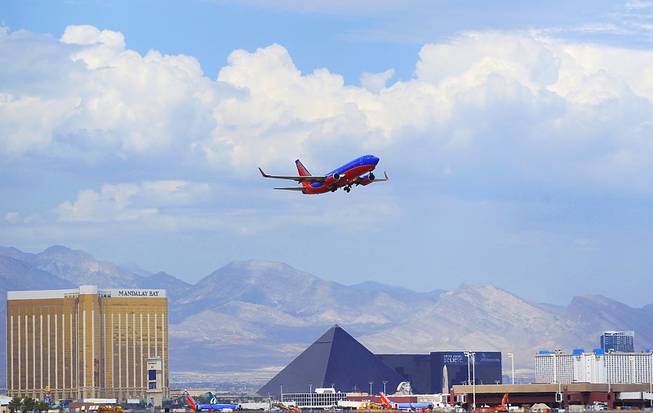
A Southwest Airlines jet takes off from McCarran International Airport on Friday, Aug. 26, 2011.
Thursday, April 19, 2012 | 8:39 a.m.
Southwest Airlines rode a stable financial strategy that helped it grow in the 1990s — a favorable fuel hedging program — to a profitable first quarter this year, surprising analysts who were anticipating a rare quarterly loss for the airline.
The Dallas-based carrier, by far the busiest operator at McCarran International Airport, today reported net earnings of $98 million, 13 cents a share, on revenue of $3.99 billion for the quarter ending March 31.
That compares with net earnings of $5 million, 1 cent a share, on revenue of $3.1 billion a year ago.
Without the favorable fuel hedging program, Southwest would have reported a net loss of $18 million, 2 cents a share, in the 2012 quarter compared with net income of $20 million, 3 cents a share, in the first quarter of 2011.
Analysts were anticipating a loss of 5 cents a share for the quarter.
Hedging involves purchasing fuel at prices agreed upon in advance. Southwest has had one of the most successful fuel hedging programs in the industry over the years but occasionally has been burned by sudden declines in the oil market that end up requiring it to pay more.
Gary Kelly, chairman, president and CEO of Southwest, said high fuel costs continue to pressure the airline with a $478 million increase in the price over the 2011 quarter.
“Despite a modest loss, excluding special items, our first-quarter results were notable, with outstanding revenue production and, except for jet fuel, better-than-expected operating costs,” Kelly said in a release announcing earnings.
More passengers, many as a result of the company acquiring AirTran, and higher ticket prices propelled Southwest to record first-quarter revenue.
“Record first-quarter revenue results were produced with strong revenue management and network optimization, along with benefits from the AirTran acquisition and all-new Rapid Rewards (the company’s loyalty program),” Kelly said. “First-quarter 2012 passenger revenues, on a unit basis, increased 5 percent compared to first quarter last year, representing a 15 percent improvement over two years, and over 30 percent improvement since first quarter 2009. Traffic and booking trends, thus far in April, are solid.”
The company’s second quarter is expected to mark the beginning of what should be monthly gradual capacity growth in the Las Vegas market.
The number of seats coming into McCarran will grow for two reasons — beginning in May, Southwest will begin flying its new, larger-capacity Boeing 737-800 jets in some markets, and cabin makeovers that will add an extra row of seats to its 737-700 jets will come on line.
Bill Owen, lead planner, network planning technology for Southwest, said the 737-800 jets would make their Las Vegas debut on Memorial Day weekend on flights to long-haul destinations suitable to the larger plane. The larger-capacity planes will require an additional flight attendant on each plane.
Owen said the 175-passenger jets would be used on flights 958 and 419 to Baltimore-Washington International Airport and on Flight 352 to Buffalo, N.Y.
Two 800-series planes began revenue service for Southwest earlier this month. Between 26 and 30 of the larger jets will be delivered to the airline from the Boeing factory over the rest of the year, the only model Southwest is getting in 2012.
The 800-series planes will be certified for flights over water, fueling speculation that Southwest could be on the verge of announcing service to Hawaii, a strategy the airline has discussed as a long-term goal. The airline also is looking at international service to Mexico and to Caribbean islands.
Meanwhile, the company will embark on cabin makeovers for its fleet of 372 700-series planes beginning in the summer, bumping up capacity in those planes from 137 to 143 seats. The transition, expected to be completed by mid-2013, will occur during aircraft maintenance cycles.
Owen said the conversion is a “surprisingly quick process” that takes just a few hours to complete.
Southwest will add WiFi capability and the company’s high-tech Evolve interiors to each plane in the makeover.
Owen said the 800-series planes are being delivered with WiFi and enhanced interiors with larger capacity overhead bins that push through the cabin ceiling.
Southwest recently tweaked its Las Vegas schedule for the fall, and Owen said there would be fewer capacity reductions in the fall months because of strong market projections, likely from the city’s robust convention schedule.
Among the tweaks for Las Vegas will be the return of nonstop flights between McCarran and Detroit and Norfolk, Va. In addition, Southwest is transitioning some of its AirTran flights to the Southwest brand. Customers will see that on the Las Vegas-Milwaukee route, which will increase from three to four flights a day beginning Sept. 30.
Owen said other changes may be in store as Southwest gears up to serve the AirTran markets of Des Moines, Iowa, and Dayton and Akron-Canton, Ohio. Initially, there won’t be any nonstop flights from McCarran to those destinations, but Owen said customers could buy one-stop tickets connecting through Denver and Chicago’s Midway Airport.

Join the Discussion:
Check this out for a full explanation of our conversion to the LiveFyre commenting system and instructions on how to sign up for an account.
Full comments policy